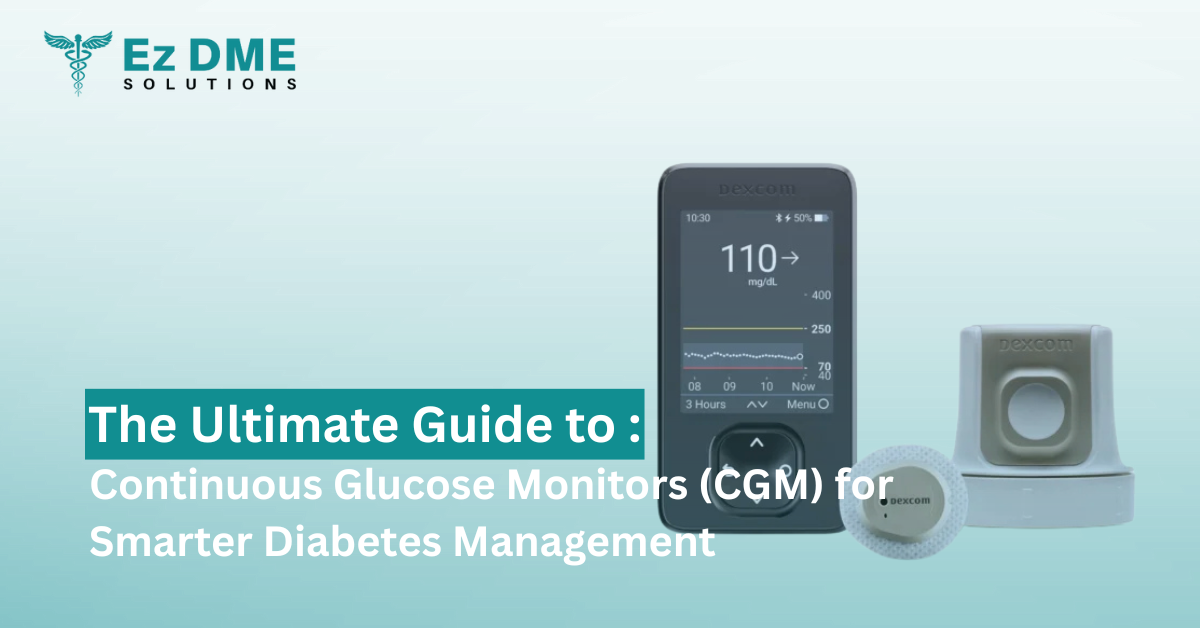No products in the cart.
The Ultimate Guide to Continuous Glucose Monitors (CGM) for Smarter Diabetes Management
Continuous Glucose Monitor for Diabetes has become one of the most important tools in modern diabetes care. Unlike traditional fingerstick testing, CGMs give you a continuous stream of blood sugar data, helping you stay in range, reduce complications, and live with greater confidence.
According to the American Diabetes Association (ADA), maintaining stable glucose levels is key to reducing long-term complications like nerve damage, kidney disease, and heart problems. CGMs are now recognized as essential Durable Medical Equipment (DME) for patients with both Type 1 and Type 2 diabetes.
In this article, we’ll explore how CGMs work, their benefits, insurance coverage, and how to access them through EZ DME Solutions.
What is a Continuous Glucose Monitor (CGM)?
A Continuous Glucose Monitor is a small wearable device that tracks glucose levels 24/7. A tiny sensor is inserted under the skin, and readings are transmitted to a receiver, smartphone app, or insulin pump. Unlike single-point fingersticks, CGMs show glucose trends over time, allowing you to spot highs and lows before they become dangerous.
Benefits of Using a CGM for Diabetes
- Better Time in Range (TIR): CGMs help patients stay within their target range longer, reducing both highs and lows.
- Lower A1C: Multiple studies, including NIH research, show that CGM use reduces A1C by 0.5–1% compared to fingersticks.
- Fewer Fingersticks: Devices like the Dexcom G6 and FreeStyle Libre 3 do not require calibration.
- Alerts & Predictive Warnings: Get notified when glucose is trending high or low, especially overnight.
- Improved Quality of Life: Patients report less anxiety, greater independence, and better sleep.
CGMs and Type 1 Diabetes
For people with Type 1 diabetes, CGMs are often life-changing. The ability to track glucose in real-time helps with insulin dosing decisions, reduces hypoglycemia risk, and improves long-term outcomes. Many insulin pumps now integrate directly with CGMs, creating automated “closed-loop” systems.
CGMs and Type 2 Diabetes
Traditionally, CGMs were used primarily for Type 1, but research shows they are equally beneficial for Type 2 diabetes. Patients on insulin therapy, or those struggling with unpredictable blood sugar levels, can use CGMs to improve A1C and lifestyle flexibility.
Top Continuous Glucose Monitors Available in 2025
- Dexcom G6: No calibration, customizable alerts, integrates with insulin pumps like t:slim X2 Basal-IQ.
- Dexcom G7: Slimmer design, shorter warm-up time, and even easier application.
- FreeStyle Libre 3: Smallest CGM available, real-time Bluetooth streaming, 14-day sensor wear.
Insurance and Medicare Coverage for CGMs
The good news is that Medicare and most private insurers now cover CGMs as DME. To qualify, patients usually need:
- A diabetes diagnosis (Type 1 or Type 2).
- Proof of insulin use (multiple daily injections or pump therapy).
- A prescription from a healthcare provider.
At EZ DME Solutions, we help patients check insurance eligibility and get CGMs delivered quickly.
How to Order a CGM from EZ DME Solutions
Ordering a CGM is simple with EZ DME Solutions. You can:
- Visit our online shop and browse CGM devices.
- Check insurance eligibility with our support team.
- Get direct-to-home delivery, often covered by Medicare or private insurance.
Conclusion
Continuous Glucose Monitor for Diabetes is not just a tool—it’s a life-changing device that empowers patients to live healthier and safer lives. With better glucose insights, reduced A1C, and fewer fingersticks, CGMs have become essential DME for anyone managing diabetes.
At EZ DME Solutions, we provide top CGMs like Dexcom G6 and FreeStyle Libre 3 with fast insurance approval and delivery. Take control of your diabetes today with the right tools and support.






Leave a Reply